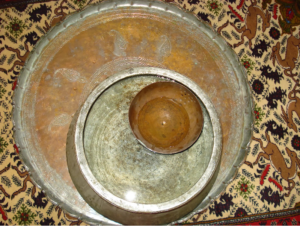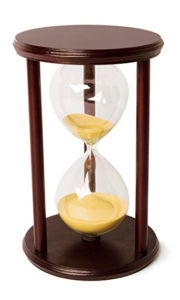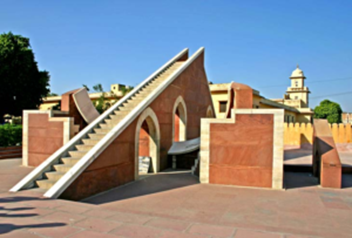Science > Physics > Units and Measurements > Measurement of Time
In this article, we shall study techniques of measurement of time.
Time is the interval between two events. The study and science of time measurement is called chronometry or horology. Chronology, as opposed to chronometry, is the science of arranging events in their order or sequence of occurrence in time and is mainly used for studying the past (history).
The events which repeat after the same and equal interval of time are called periodic events. e.g. the motion of a bob of a simple pendulum, motion of needle of a sewing machine, etc.
In everyday practice, we use the 12-hour clock system. Airlines and Railways use the 24-hour clock system. 2:15 a.m. in 12-hour clock system equals 2:15 in the 24-hour clock system. 2:15 p.m. in a 12-hour clock system equals 14:15 in the 24-hour clock system.
Time can be measured using a simple pendulum, stopwatch, atomic clock. The time measuring instruments exhibit two basic components: (1) a regular, constant, or repetitive action to mark off equal increments of time, and (2) a means of keeping track of the increments of time and of displaying the result.
Time measurement is very important because the time can be considered as a common language between people and due to which everybody proceeds in an orderly manner in this fast-paced world. The time is important for keeping social interactions.
The oldest and most used method of measuring time is based on the earth rotating about its axis due to which the day and night occur. Rising and setting of the sun is considered as a periodic motion and is considered as the reference for measuring time. For primitive peoples, it was sufficient to divide the day into the early morning, mid-day, noon, late afternoon, night and late night. Due to further development of science and technology and due to more social interactions, there was a need to divide the day more precisely. The modern convention is to divide the day into 24 hours, an hour into 60 minutes, and a minute into 60 seconds (Babylonians 1900 b.c..–1650 b.c.). Babylonians have a great fantasy for number 12 and its multiples.
Old Time Measurement Techniques
Ghatika Yantra:
Ancient Indians devised a different type of clock, based on water, called as ghatika yantra. They divided day and night into 60 parts, each of which is called a ghari. The night and day are each divided into four parts each of which is called prahar. The kings used to have a group of men called ghariyalis appointed to measure time. A small vessel with a small hole at the bottom was placed over water contained in another big vessel. The water from the big vessel enters the small vessel with a hole. When the vessel with the hole was filled with water and sank, ghariyalis used to strike the ghariyal (the gong), a thick brass disc hung at a high place with a mallet. This indicated a certain period of time.

Sand Timers:
An hourglass (or sandglass, sand timer, or sand clock) is a device used to measure the duration of time. It is cannot be used to find the exact time but can be used to measure a predetermined time interval. It comprises two glass bulbs connected vertically by a narrow neck that allows a regulated trickle of sand from the upper bulb to the lower one.

Sand quantity, its coarseness, bulb size, and neck width determines the rate of flow of sand from the upper bulb to lower. They can be reused indefinitely by inverting the bulbs once the upper bulb is empty.
Sundial:
The simplest time measuring device in the old days was a stick put vertically in the sand. In the Greek language, the stick or the pillar whose shadow is used to measure the time is called the gnomon. The shadow of the stick was used to measure time.

Sundials are the oldest known devices that are used for time measurement. It depends on the rotation and movement of the sun. As the sun moves from east to west, the shadows formed change their position depending on the position of the sun at that instant using which we can predict the time of the day. The Egyptians were the first to use the sundials. Time was calculated depending on the length of the shadow. The plate on which the shadow of gnomon falls is called faceplate. This plate is flat but it can be shaped spherical, circular, conical or just about any shape. The face has markings on it to indicate the time.

Due to the tilted axis of the earth sundial will show a different time each week. The difference in time is compensated by aligning the gnomon with the earth’s axis.
The Jantar Mantar the largest stone sundial is constructed by Maharaja Jaisingh – II of Jaipur, India. It is an equinoctial sundial. Equinox is a day when the sun is exactly on the equator of the earth. The sundial consists of a gigantic triangular gnomon with its hypotenuse parallel to the Earth’s axis. On either side of the gnomon is a quadrant of a circle, parallel to the plane of the equator. It measures the time of day, corrects up to half a second.

Simple Pendulum:
Mechanized Clocks:
The escapement is a mechanism in a clock or watch that alternately checks and releases the train by a fixed amount and transmits a periodic impulse from the spring or weight to the balance wheel or pendulum. This mechanism was activated by falling weight or water.

The length of the pendulum is so adjusted that the cogwheel would move at the rate of one tooth per second.
Previous Topic: Measurement of Density
Next Topic: Dimensions of Physical Quantities
